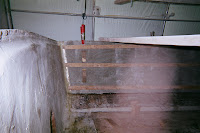
























 After the stringers were removed, I took some epoxy with some 404 filler and filled in all the strakes and channels where the stringers were located. I did this to reinforce the hull. After removing the stringers down the middle of the boat I had to remove some old glass. I then took some six inch bi-axle and laid it along were the old stringers were. Then I cut two pieces of 1708 and laid right down the middle. After it cured you could really fill the difference in the stiffness of the hull. The plan is add one more layer of 1708 six inches wider on both sides than the first one. I'm going to finish fairing out the bottom of the hull with epoxy with 404 filler. The next step will be to reinforce the hull sides with 3/8" coosa, I will be vacuum bagging for this process. Then I'm going to add four layers of glass to the entire bottom of the hull from bow to stern. My lay up schedule will be as follows : woven roven, matt, woven roven, matt. After all of this is done I'm going to build and install my new stringers. The stringers will be made with foam glassed in with six layers of 1708.
After the stringers were removed, I took some epoxy with some 404 filler and filled in all the strakes and channels where the stringers were located. I did this to reinforce the hull. After removing the stringers down the middle of the boat I had to remove some old glass. I then took some six inch bi-axle and laid it along were the old stringers were. Then I cut two pieces of 1708 and laid right down the middle. After it cured you could really fill the difference in the stiffness of the hull. The plan is add one more layer of 1708 six inches wider on both sides than the first one. I'm going to finish fairing out the bottom of the hull with epoxy with 404 filler. The next step will be to reinforce the hull sides with 3/8" coosa, I will be vacuum bagging for this process. Then I'm going to add four layers of glass to the entire bottom of the hull from bow to stern. My lay up schedule will be as follows : woven roven, matt, woven roven, matt. After all of this is done I'm going to build and install my new stringers. The stringers will be made with foam glassed in with six layers of 1708. 

















Here is another winter project. When I bought the boat the engine was a fresh new long block. Recently rebuilt by a machine shop in Hopewell Va. The engine is a 1972 Chevy 400 small block with 4 bolt main caps. The engine came out of an old school bus. The engine was bored 30 over and the crank is a brand new out the box steel crank. The heads are 350 heads that were drilled for the steam ports that are in the 400 block. It also has the original bow tie high rise intake manifold. It has the typical marine cam with a double roller timing gear set. So when I got the engine I bought and installed a new Holly 750 double pump 4 barrel manual choke carburetor. New manifolds and risers and a fresh water cooling system. New starter, wires, plugs, cap and rotor. New flywheel and fuel filter. When the shop built the engine they said it has at least 330hp maybe a tad more. I know when I had everything put together and started it up in my garage it sounded BAAD! In fact it sounded so bad my asshole neighbor called the police on me for disturbing the peace. I can't wait to put this motor in. With the hp and the weight of my boat and the out drive I have. This boat should do at least 60mph maybe 62mph. The out drive is a Volvo 290 DP. I wanted to add that when I took these pictures, the original carb was on it which had an electric choke. This engine replaces the original engine which was a Chevy 350 270hp. That's why you see the original carb cover with AQ271C.